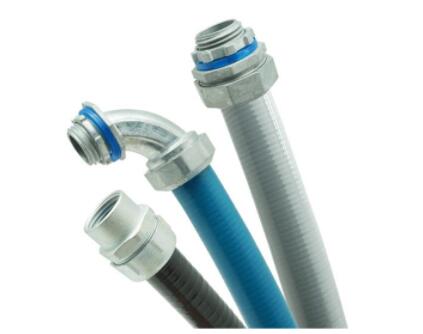Dec. 07, 2021
Today, the options are seemingly endless when it comes to choosing a liquid-tight wire management solution for your application. With so many options, it's easy to see why someone might feel overwhelmed when choosing the right liquid-tight wire management equipment. We hope to dispel that overwhelming feeling by answering some common questions about liquid-tight conduit and accessories and liquid-tight wire clamps. By the way, the term cable sealing jacket can be used interchangeably with cordgrip.

Stress Relief
Conduits and Fittings
A common misconception about liquid-tight conduit and fittings is that it relieves strain on the cable. While liquid-tight conduit does provide some relief, it actually provides more of a protective barrier between the cable and any environment it may be installed in. (Kind of like your jacket, protecting you from rain and snow.) But how is this different from a waterproof rope, you may ask?
Liquid-tight rope handles
Liquid-tight rope grips differ from liquid-tight conduits and fittings in that they provide strain relief directly to the cable. the industry standard established by UL is a 35 lb. pull. This means that 35 pounds of horizontal tension can be applied to the cable before it begins to pull out of the rope or application.
In applications where cable movement, vibration and strain are expected, liquid-tight rope clamps may be a better choice.
Environmental Protection
Conduits and Accessories
Liquid-tight conduits are ideal for use in environments that may become wet. Used in combination with liquid-tight accessories, conduits prevent moisture from entering. If the application requires the use of a liquid-tight fitting with conduit, be sure to screw the fitting onto the connection, or use a junction box. This type of conduit can also be used in applications where wires or cables may be exposed to corrosive elements. An example of such an application is the use of conduit for condensers in air conditioning units.
If installing wire or cable in an outdoor application, use a metal version of liquid-tight conduit with a PVC outer jacket and stabilizer to provide additional protection against the elements, including solar UV. This type of conduit is also suitable for applications that require bending or anticipated vibration.
Catheters with an electro-galvanized steel inner core are highly resistant to bending and vibration. The core of the conduit also has a plasticized PVC coating that provides oil resistance and optimal performance in high temperature applications.
Liquid-tight conduits also provide adequate protection against dust and certain types of fluids. Most importantly, these conduits are mechanically strong, making them the preferred choice when making secure connections is critical.
Use these conduits if your application requires undergrounding of cables. Liquid-tight conduit provides adequate protection against moisture and pressure, even when buried underground. However, be sure to note that you should choose to use conduits no larger than one inch in diameter. Why? Larger diameter conduits are not suitable for concrete encasement.
Finally, these conduits can be used for low heat applications - dry heat up to 80 ° C and wet heat up to 60 °C.
Liquid-tight rope handles
Nylon rope grips may also have the highest IP rating - up to IP68. What is an IP rating? IP rating is ingress protection and defines the level of sealing effectiveness of the electrical enclosure against foreign objects, such as dust and moisture.
Installation
Conduits and fittings
Over the years, as applications have become more and more complex, so have the components used in them. That said, we offer a variety of fittings to meet the requirements of each application. The most common fittings have threads (NPT, PG or metric) that engage the threads on the housing/application to ensure a liquid-tight seal. These fittings can also be installed on housings/applications without threads with the help of locknuts.















